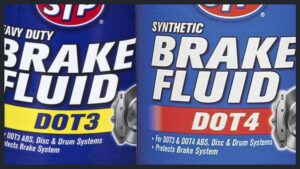
DOT 3 vs DOT 4 Brake Fluid (Differences and Boiling Points)
Modern braking systems use hydraulic pressure to transfer power from the brake pedal to the brake calipers. Brake fluid is a specialized hydraulic fluid that can withstand the high temperatures generated by braking. Brakes convert the vehicle’s kinetic energy into heat.
There are four types of brake fluid, officially named DOT 3, DOT 4, DOT 5, and DOT 5.1. The names refer to the specific chemical mixture that makes up the brake fluid.
As long as the brake fluid meets the Department of Transportation’s minimum standards, it is acceptable for use in a vehicle’s braking system. Of the four types of brake fluid, DOT 3 and DOT 4 are the most popular.
Boiling Point
If you want to understand the difference between DOT 3 and DOT 4, you need to look at the two different boiling points.
When you boil new brake fluid from a new container, you reach the dry boiling point. The other type is the wet boiling point. This refers to the boiling of brake fluid that has already absorbed water. DOT 3 fluid has a dry boiling point of 401°F (205°C) and a wet boiling point of 284°F (140°C). DOT 4 fluid has a dry boiling point of 446°F (230°C) and a wet boiling point of 311°F (155°C).
As you can see, DOT 4 has a higher boiling point, both dry and wet. This means it can withstand more heat before it starts to break down, making it better for high performance vehicles and braking in extreme conditions.
DOT3 Brake Fluid
DOT 3 is considered the standard brake fluid for regular economy class vehicles. Its chemical blend can withstand a fair amount of heat, but not as much as DOT 4.
DOT 3 and DOT 4 brake fluids are both glycol ether based. The difference in boiling point is due to the borate compounds, which give DOT 4 fluid a higher boiling point compared to DOT 3.
In some cases, DOT 4 may also have a slightly lower viscosity than DOT 3, which is an advantage for ABS systems, which actuate the valves in the ABS module very quickly. DOT 3 is required for many passenger vehicles because on the road you don’t usually brake as aggressively or frequently as you do in police or track cars.
DOT4 Brake Fluid
DOT 4 is considered a more reliable brake fluid than DOT 3 and can withstand more heat. Because it can withstand more heat, it is more reliable when the components of the brake system are used frequently in a short period of time.
It can also handle situations where other types of brake fluid have been used improperly on a vehicle. Therefore, vehicles that are heavily used, such as racing cars, police cars, and vehicles that tow heavy loads, are known to use DOT 4 brake fluid.
DOT 4 brake fluid works faster at the dry boiling point than at the wet boiling point. DOT 3 can achieve good results at both the dry and wet boiling points. Overall, DOT 4 is a very complex brake fluid that helps maintain the functionality of your brake system.
If your vehicle is compatible with DOT 4 brake fluid and you are currently using DOT 3, consider changing it at your next brake fluid change. What happens if I use the wrong brake fluid?Using the wrong brake fluid can have a major impact on braking performance. Silicone and glycol based brake fluids are not compatible. Check your owner’s manual to see what type of brake fluid is recommended for your specific vehicle.
Can I use DOT 3 brake fluid instead of DOT 4? No. DOT 3 has a lower boiling point than DOT 4, so don’t use it where DOT 4 is required.
Can I use DOT 4 fluid instead of DOT 3?Yes. DOT 4 is a direct replacement for DOT 3 and can be used safely at a higher temperature range. DOT 4 fluid absorbs water more quickly, so in some cases, it may require maintenance at shorter intervals. Can I use DOT 5.1 instead of DOT 3 or DOT 4?Yes. Like DOT 3 and DOT 4, DOT 5.1 is glycol based, but it remains a liquid even at high temperatures. The downside is that DOT 5.1 absorbs water much faster than DOT 3 or DOT 4 fluids, so it must be changed more frequently.
Can I use DOT 5 instead of DOT 3 or DOT 4? No. DOT 5 is silicone based and completely incompatible with other brake fluids. DOT 5.1 is compatible with DOT 3 and DOT 4, so the naming convention is very confusing.
Can I reuse brake fluid? No, we strongly recommend not reusing brake fluid. Brake fluid absorbs moisture when exposed to air. Water lowers the boiling point of brake fluid, making it very dangerous to reuse old fluid.
Conclusion
You may be wondering why DOT 3 brake fluid isn’t being replaced everywhere if DOT 4 is so much better. This is a good question, as the price difference between these two brake fluids is very small.
What’s important is the regulatory approval of DOT 3. There are more vehicles approved for use with DOT 3 brake fluid than DOT 4. However, this may change as stricter regulations regarding the safety and functionality of braking systems come into force.

